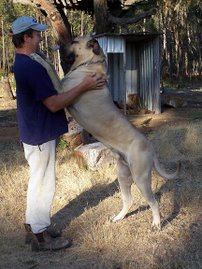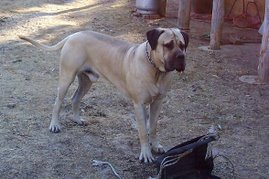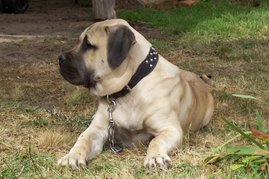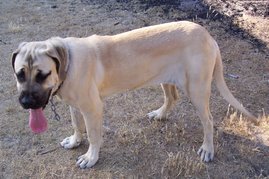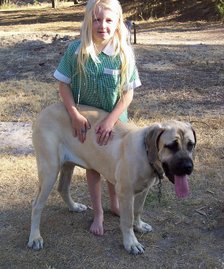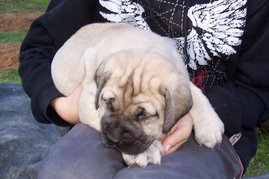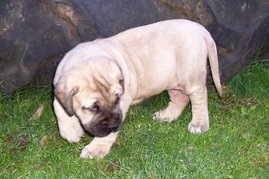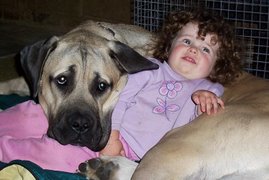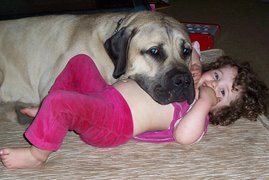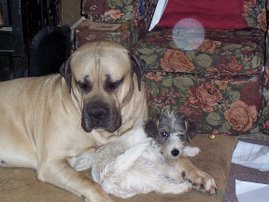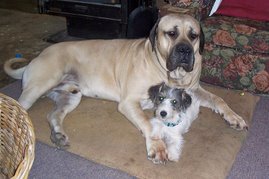A Brief History:
Physical Characteristics:
Pros & Cons of owning a Mastiff:
What to look for:
Availability:
Cost:
Purebreed? Pedigree? Registered? Papers? Guarantee?
Blog Archive
Friday, January 5, 2007
those first few weeks with your new puppy...
BEFORE YOU LEAVE TO PICK UP YOUR PUPPY:
- Section off a small area for your dog and "toddler proof" your home and/or outdoor area eg. dangling electrical cords, slippery surfaces, gaps in fencing, small items for choking risk etc all need to be taken care of. A puppy is just like a small child
- make sure you have called a few vets in your area and determined if there are any who specialise in large breed dogs.
- your breeder should have given you a diet and care sheet before you pick up your puppy, this will enable you to have all the correct food and any medication (worming treatments and the like) ready.
- when travelling always have a suitable crate so your puppy can be safely contained, holding them on your lap is not safe!
- ideally the breeder will not have fed the pup since the night before you are due, this will minimise the chances of the dog being ill or making a mess. Always stop every hour or so to let your pup out. Bring an empty bottle with you so you can fill it up at the breeder's house for the trip home. You can buy collapsible water containers for use when travelling - a plastic shower cap will also do the job.
- bring a towel or similar cloth with you and get the breeder to rub it all over the mother before you leave. Spread it over the pup's new bed when you get home and he/she will accept it.
- bring newspaper with you and either ask breeder to give you a piece the pup has already toileted on or keep a piece from the journey home. Place this in the area where you would like your pup to toilet.
WHEN YOU GET HOME:
- keep puppy contained in a small area, giving him/her the run of the house will not only make toilet training difficult but it will overwhelm the pup.
- don't feed pup for at least 3 hours after travelling, leave only fresh water.
- make sure pup's bed is not too big, they like a small cosy nest to sleep in. When sleeping with their litter mates they are all squashed up into a tight ball so like the safety of confinement. Most pups cry at night due cold, a small cosy bed will help prevent this.
- if bringing home a pup with children in the house make sure the children understand that when pup is in it's bed it isn't to be touched, puppies need an enormous amount of sleep or they will fail to thrive and become bad-tempered. A large cage is ideal for this purpose, when pup is in the cage it shouln't be touched, when it chooses to come out then playtime can commence.
TOILET TRAINING:
- if keeping dog indoors hopefully you have a huge stockpile of newspapers collected before you bring your pup home. As suggested above, put a piece of used paper on top of the fresh paper to help pup know the appropriate place to toilet. It is always wise to place this paper near a door, it makes the transition to outdoors easier.
- if dog is kept outdoors, take pup to the place you would like him/her to use. Always leave one poo in the place you want pup to use, if you remove all the poo everyday then pup will have trouble knowing the correct area.
- the best times to take pup out to toilet are when he/she wakes, after exercise or playing, half-way through mealtime and about half an hour after mealtime. If you take pup out half-way through a meal you will find pup eats better.
Friday, December 15, 2006
HIP & JOINT PROBLEMS genetics vs diet vs environment
Lameness and limping in puppies is common around the 5-9 month stage. The cause/s are usually one - or a combination of - genetics, diet or environment. Once you have identified the cause/s, then comes the confusing job of indentifying the condition (or giving the limp a medical name or diagnosis). Most people immediately jump to the conclusion that because you have a giant breed dog it must be hip dysplasia (or HD). But it could be other conditions - some of them temporary, some more serious. Some potential conditions are panosteitis, soft tissue injury, ligament/tendon damage or hip dysplaysia. I will include some links for further information on these here:
1. Panosteitis (or pano):
http://www.peteducation.com/article.cfm?cls=2&cat=1561&articleid=466
http://www.lowchensaustralia.com/health/pano.htm (particularly good piece with lots of links at the end)
2. Hip Dysplasia (or HD):
http://www.peteducation.com/article.cfm?cls=2&cat=1569&articleid=444
http://www.spinone.com/hipdysplasia.htm
3. Various potential reasons for limping:
http://members.aol.com/RocknRob56/limping.html (Mastiff specific info)
http://www.2ndchance.info/limping.htm
HIP DISPLAYSIA... GENETICS vs DIET vs ENVIRONMENT: the three-headed beast!
Simply put HD means poorly-formed hips, or hips that do not fit into their socket (read links above for a more detailed explanation). If your puppy (or adult) is diagnosed with HD you are probably wondering why it happened and what you did wrong. There are 3 main factors influencing whether a dog will or will not get HD. These are genetics, diet and environment.
1. Genetics: a dog is born with the problem due to defective genes in the parent/s. To which your answer may be "but the breeder told me the parents have had HD x-rays and my puppy has a guarantee" There is no guarantee that dogs screened for HD will not have offspring with the disease. Genetics are only thought to be a MINOR contributing factor. Simply put, even if a breeder assures buyers their dogs have been 'hip scored' (x-ray showing if HD is/is not present) and they guarantee their puppies then they are misleading the buyer. THERE IS NO GUARANTEE YOUR PUPPY WON'T HAVE HD! Even the most knowledgeable of scientists cannot agree on a single contributing factor for HD, hip scoring of adults is not eradicating the disease! Many vets and scientists believe that genetics play no part (read points 2 and 3 for the reason why).
2. Inappropriate Diet. Is thought to be a major contributing factor. The following quote shows an undeniable link between diet and HD:
I've included further detailed information in the diet section (see previous posts).
3. Environment: Studies have shown that another BIG contributor is exercise. This is either:
1. excessively exercising puppies and adults, allowing adults/pups to ‘rough house’ or play rough with each other, walking dogs up or down stairs and just over-walking in general. Mastiffs are lazy by nature, a plod around outside or a short stroll is all they need.
2. Not exercising your puppy enough - What!? I hear you say... but you just told me exercise causes problems! Excessively exercising your dog does, but weight-bearing exercise is crucial for healthy joints and hips that are 'ground in well' into their sockets. Many owners make the mistake of keeping their dog confined inside while they are away at work therefore the dog gets very little exercise. Then when you get home and let them out they go nuts! This is when injury will more than likely occur. This direct quote from Breeder Vet Journal explains this"
Their litter mates in private homes, where exercise is confined to an hour or two of intense play or jogging when their owners return from work, provide us with a different set of observations.
They grow very large, very fast. They often suffer injury. They frequently have hip sockets of different depths".
http://www.peteducation.com/article.cfm?cls=0&cat=1448&articleid=670
Wednesday, December 13, 2006
VACCINATIONS, pros/cons and our story...
The current Victorian local (government) council vaccination schedule is:
6-8 weeks old: Distemper/Hepatitis/Parvovirus
12-14 weeks old: Distemper/Hepatitis/Parvovirus
16-18 weeks old: Parvovirus
Then every year: Distemper/Hepatitis/Parvovirus
Many vets have a different schedule to this, check with yours. The following is another vet-recommended schedule:
6-8 weeks: Distemper, Hepatitis, Parvovirus
12-14 weeks: Distemper, Hepatitis, Parvovirus & Kennel Cough (C4 and/or C5)
16-18 weeks: Kennel Cough (C4 and/or C5)
But firstly I’d like to share our story. When we had Bullmastiffs (before we upgraded!) we were under the impression that the Vet knew best and sadly this wasn’t the case.
We had our Bullmastiff vaccinated at the (vet) recommended 6 week stage. Soon after he became ill - very ill - with vomiting and diarrhoea. He ended up being dragged back and forth to the Vet (and the $$$ in vet bills multiplying! – not that we cared, we loved him) and eventually on a drip. He was hanging between life and death for 48 hours and then miraculously pulled through. That wasn’t the end. His rehabilitation meant enzyme based (expensive) food as he couldn’t tolerate anything as his intestinal tract and bowel were damaged.
I began reading about why this had happened and what I found out about vaccinations shocked me. Please take the time to read as many of these articles as you can, discuss them with your vet and make up your own mind (note these are overseas sites and their schedule and list of some diseases like rabies don’t apply to Australia, but what I want you to read is the adverse reactions if given too early):
1. http://www.angelfire.com/biz/froghollerfilas/VaccBlanco.html
2. http://www.dogs4sale.com.au/Notice_Board_Dogs_World_UK.htm
3. http://www.shirleys-wellness-cafe.com/petvacc.htm
I am not a vet or have any veterinary qualifications so please direct your enquiries about the best course of vaccinations for your puppy with a vet you trust. In no way am I advocating not vaccinating your dog, just not to do it so early. Waiting until around 10-12 weeks is much safer and unless you are kenneling your dog the risk of catching the diseases the vaccinations protect against is small. I only have my dogs vaccinated up until the age of 12 months, I do not believe in annual booster vaccinations – again, my personal preference.
OUR POLICY REGARDING VACCINATIONS OF PUPS FOR SALE:
Our policy is for the pups to go to their new homes at around 6 weeks of age. Mastiff puppies wean much earlier than smaller breeds of dog so they are not reliant on their mother’s milk for several weeks prior to this.
When the pup has been in your home – happy, healthy and eating well for AT LEAST 2 WEEKS (preferably longer) then you organise to get pup vaccinated with a vet of your choice. Benefits for this is the pup is less likely to have an adverse reaction due to the stress of moving to a new home soon after, or just prior to, being vaccinated. This is done solely for the purpose of the pup’s wellbeing and not our hip pocket! The first vaccination is a cheaper one (around $30 – less for people like us who can get the litter done in bulk).
EXCEPTIONS TO THIS RULE:
If the pup is to be freighted interstate or overseas on a long flight then their chances of being in contact with other traveling animals with diseases is a real possibility. As most freight companies don’t take dogs until at least the 8-12 week mark then getting an early vaccination may be a good idea. Again, speak to your vet and make this decision yourself! I am willing to vaccinate if you would prefer it under this circumstance.
Saturday, December 9, 2006
Growth and your Mastiff, is bigger always better?
We raise Mastiffs not as show ponies or crowd pleasers, but as working members of our family. They are not much good at their job of guarding if they can't give chase without collapsing on the ground exhausted after a few steps.
Growth patterns.
Mastiffs spend their first 8 weeks as boofy little bundles of wrinkles as the photos of 5 week olds to the right show) with very little nose. This 'snub-nose' look enables the pups to be able to suckle milk from the dam - a bit like human babies. They will put on approximately 1 kilogram per week.
In the 3-9 month stage they go through the tall gangly teenager look, all legs and often quite skinny with enormous paws in comparison. They are very uncoordinated and klutzy. They will often have periods of rapid growth and voracious appetite then periods of not eating, so much to the point that you get worried and think they must be ill. It is at this point most owners start changing the diet and tempting them with all sorts of foods. Avoid this at all costs! You will end up with a fussy eater who develops a taste for the wrong types of food. Continue to give the same diet regardless of the dog refusing.
Personally I think this stage is a self-preservation one, they have an innate ability to know what they need and when they need it - like they know how to protect their own joints! Weight gain is highly variable at this stage but it should slowly increase. Don't try to get rid of that skinny look by overfeeding, it is a normal stage.
During this stage you will notice your Mastiff grows at an uneven rate. At times he/she will seem taller at the rear than the front, other weeks it is the reverse and they look almost like a German Shepherd with the shoulders taller than the rump. These lopsided growth spurts are normal and not to worry about - they are not a sign of 'dodgy' genetics or bad breeding.
Think about desexing your animal in this period if you don't want them to breed. Don't believe all you read about sexual maturity or breeding age at 12-15 months. Someone we knew ended up with an unexpected and unplanned litter when their 9 month old got pregnant!
9-15 months you will see a rapid gain of muscle as the dog begins to fill out. Maintaining a steady diet is important so this doesn't happen too quickly. MOST females will reach sexual maturity during this time - factor this in if you don't want to breed and haven't previously de-sexed her (or him!).
In the earlier stages growth can still be a little lopsided and uneven (as above) towards the later stages much of their height has been attained so it won't be as noticeable.
2-3 years is when a Mastiff is considered an adult. This doesn't mean they have stopped growing! They will continue to fill out and gain size (outwards rather than upwards). So if your Mastiff reached the optimum recommended weight in the previous stage you know you could have a potential problem, as they are still gaining at this age. Cut down on the calories and give more raw chicken than red meat. The animal should display good form now, the previous un-even growth pattern should have ended and it should have a nice straight back. Many consider them to be at their prime at 4 years of age.
Thursday, December 7, 2006
can I buy a puppy if I live interstate or overseas?
There are many companies that perform this service - I have regularly used DogTainers - but there are others. For interstate or international buyers the usual procedure is I drop the pup off near Avalon airport and the dog is transported into the airport by DogTainers as this reduces the cost to you. They will also deliver anywhere locally (within Victoria).
The benefit of using companies like these is they take care of everything - crate, booking, loading and unloading. Prices depend on the level of service you require. Door-to-door is more expensive (pick up from my house and taken directly to yours). Airport-to-airport is cheaper or a combination of these can be arranged. Local delivery can only be door-to-door.
The following is a list of companies who transport dogs - most have an online quote system:
1. DogTainers (domestic and international service):
http://www.dogtainers.com.au/
2. Pet Carriers International (domestic and international service):
http://www.petcarriers.com.au/
3. OZPet Transport (domestic and international service):
http://www.ozpet-pettransport.com.au/
4. Jet Pets Animal Transport (domestic and international):
http://www.jetpets.com.au/
5. Pets Transport (domestic service only)
http://www.petstransport.com.au/
I have no affiliation with nor get any financial or other benefits from any of these companies. I have only used DogTainers so cannot guarantee the level of service from any of the other carriers - links are provided for your information only.
Diet - commercial vs natural and BLOAT
Diet:
As previously mentioned, a fully-grown Mastiff will eat the same amount as a German Shepherd. When you are raising a puppy though, they will eat more as they grow rapidly – on average 1-2 kilos per week. The emphasis needs to be on QUALITY of the food, not the QUANTITY.
Giving dietary advice is like giving child rearing advice. There are 2 strong camps usually in direct opposition (namely commerical food vs raw food) with a few in the middle with a 'bit of everything' approach. Read up about both and make your decision based on fact - but consider the source of the information and their bias. Vets are supposed to be a great source of impartial advice with only your dog's health in mind - but did you know many operate on a kick-back system with the commercial pet food manufacturers?
If you use commercial food, only use one designed for giant breeds. AVOID "PUPPY" FOOD AT ALL COSTS! It is too rich for giant breeds and forces them too grow too quickly - placing stress on their joints and guaranteeing hip/joint problems later in life. Studies have been done on this and many have been published on various Vet sites and magazines - this is a direct quote from one:
"Some years ago, half of a litter from a mother dog showing hip dysplasia was given all the puppy food they would eat; the other half was given limited quantities of adult dog chow. As the pups matured, the ones given the puppy chow developed hip disease but the ones given adult dog chow did not." (find the full article here: http://www.petpages.com/article.php/10/32/Joint-and-Back-Pain-in-your-Pet)
I will reveal my personal bias here and state up front I am not a fan of commercial food. I only use this as an addition to, not the basis of, my dogs’ diet. We favour raw food – bones, fruits and vegetables. Our dogs’ diet is made up of lamb necks, lamb ribs (or brisket), chicken frames, raw vegetables and raw fruits (yes they really do eat them! Our Mastiffs graze off our fruit trees – we didn’t teach them this, they do it by instinct). I do give a small amount of commercial dry food as it contains trace minerals and also because it is convenient. Further information about other negatives to commercial food can be found here:
1. http://www.yourpurebredpuppy.com/health/common/feeding.html (wondering what goes into commercial food? You may be surprised!)
2. http://www.barfworld.com/html/barf_diet/barfdiet.shtml (a very popular diet for dogs called the B.A.R.F diet)
The two biggest mistakes people make when feeding their dogs are:
Too much food! Especially when you use commercial dog food as the main source of food. All brands have recommended feeding amounts and schedules – only problem is no-one ever sticks to these! Rover always gets slipped extra table scraps, training treats, bikkies, bones etc etc. These add to the calorie intake and people wonder why Rover is getting fat even though “I only give him the amount stated on the packet….”.
Incorrect balance of food. Dogs need a balance of protein, calcium, fats and vitamins/minerals. We don’t need to get the scales out and weigh everything and scientifically analyse each morsel – just some common sense! Raw foods contain all their nutrients because they haven't been cooked/processed out.
To know if you are feeding your dog correctly, look at your animal. Loose, elastic skin and a soft shiny coat means a correct fats/oils balance. Good form (feet arched like a cat, back not swayed, legs not splayed, nice straight white teeth) means animal has the correct calcium levels. Solid muscle is a sign of correct protein levels. Clear bright eyes and pink gums are evidence of trace minerals and vitamins balance.
Another (slightly gross) way to check this is to look at the dog's stools (yes, I mean poo!). A black, tarry stool is usually a sign of too much protein (red meat the likely culprit); smelly, loose and unformed stool (like a cow pat) a sign of too much fats/oils or too much starch (biggest culprit rich dry foods or canned food). The stool should be firm, formed with not much smell. After a few hours outdoors it should be dry and white like chalk - this means there is a correct amount of calcium (usually comes from eating raw bones). As far as condition goes, you should be able to see the dog's rib cage but not be able to count the ribs!
Exercise and food are linked to a serious condition in large breed dogs known as BLOAT.
The following links contain detailed information about bloat, please try to read as much as you can so you can avoid this painful - often fatal - condition:
COMMON MISCONCEPTIONS ABOUT ENGLISH MASTIFFS
These common statements usually begin with BECAUSE OF THEIR SIZE…
1. “… they must be vicious/aggressive/dangerous”
if sensibly handled NEVER! “Gentle Giants” is accurately used to describe the English Mastiff’s temperament. Most aggressive/vicious behaviour in dogs is through fear. Mastiffs know their size and strength and don’t find the need to scare people/animals with displays of aggression. They will however protect their home and family if threatened. If a foolish intruder is not deterred by their sheer size and ignores the vocal warning, the next defence of the Mastiff is to knock them over and pin them down and hold until called off. They will not bite or maul if raised appropriately.
2. “… they must be unsuitable for families with children?”
NO! Mastiffs adore young children and are exceedingly gentle and careful around them. They will often prefer the company of children over adults and will vigilantly watch over them. They good-naturedly tolerate abuse like ear, tail and whisker pulling, kids jumping on them, dressing them up etc. When playing, they have an uncanny ability to adjust their strength to suit the size of the child.
3. “… they must eat LOTS of food”
NO! When fully grown they will eat as much as your average German Shepherd. Because they are relatively inactive dogs their calorie requirement is quite low.
4. “… they must need a huge yard”
NO! Mastiffs are big lazy animals and are happy to plod around a small yard. The only requirement is a good fence.
5. “… need lots of exercise?”
NO! quite the opposite! They require a daily SHORT stroll. Don’t think this will be the type of dog you can take long walks with. I am always reminded of a story published in a dog breeding magazine about a lady who took her Mastiff on a long walk around the neighbourhood to ‘show him off’ and ended up sitting on the roadside for 2 hours until he was ready to go home!
6. “will hurt other animals cats/dogs etc”
NO! Mastiffs love company and are very gentle with all animals as they are with children. If you can’t be at home with them they need companionship – a cat or dog would be ideal. Our Mastiffs share a home with Jack Russells, goats, and chickens and get along equally as well with each. Our Russells like to snuggle up next to the Mastiffs and sleep.
